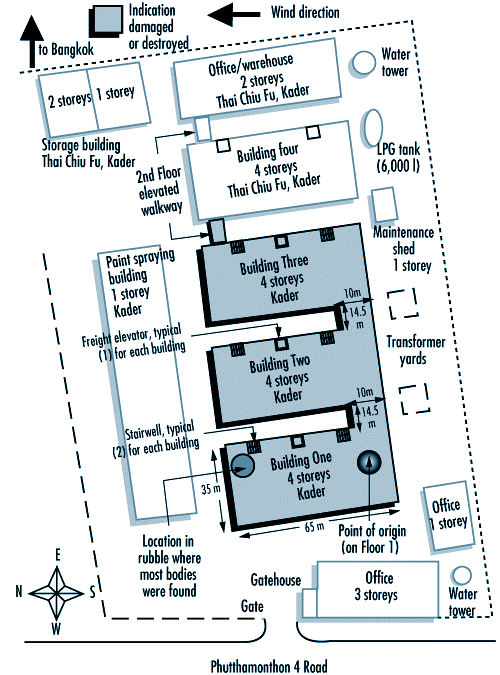1The Kader facility, which manufactured stuffed toys
and plastic dolls primarily intended for export to the United
States and other developed countries, is located in the
Sam Phran District of Nakhon Pathom Province. This is not
quite halfway between Bangkok and the nearby city of Kanchanaburi,
the site of the infamous Second World War railroad bridge
over the River Kwai.
The structures that were destroyed in the blaze were all
owned and operated directly by Kader, which owns the site.
Kader has two sister companies that also operate at the
location on a lease arrangement.
The Kader Industrial (Thailand) Co. Ltd. was first registered
on 27 January 1989, but the company's licence was suspended
on 21 November 1989, after a fire on 16 August 1989 destroyed
the new plant. This fire was attributed to the ignition
of polyester fabric used in the manufacture of dolls in
a spinning machine. After the plant was rebuilt, the Ministry
of Industry allowed it to reopen on 4 July 1990.

Between the time the factory reopened and the May 1993
fire, the facility experienced several other, smaller fires.
One of them, which occurred in February 1993, did considerable
damage to Building Three, which was still being repaired
at the time of the fire in May 1993. The February fire occurred
late at night in a storage area and involved polyester and
cotton materials. Several days after this blaze a labour
inspector visited the site and issued a warning that pointed
out the plant's need for safety officers, safety equipment
and an emergency plan.
Initial reports following the May 1993 fire noted that
there were four buildings on the Kader site, three of which
were destroyed by the fire. In a sense this is true, but
the three buildings were actually a single E-shaped structure
(see figure 39.13), the three primary portions of which
were designated Buildings One, Two and Three. Nearby was
a one-storey workshop and another four-storey structure
referred to as Building Four.
The E-shaped building was a four-storey structure composed
of concrete slabs supported by a structural steel frame.
There were windows around the perimeter of each floor and
the roof was a gently sloped, peaked arrangement. Each portion
of the building had a freight elevator and two stairwells
that were each 1.5 metres (3.3 feet) wide. The freight elevators
were caged assemblies.
Each building at the plant was equipped with a fire alarm
system. None of the buildings had automatic sprinklers,
but portable extinguishers and hose stations were installed
on outside walls and in the stairwells of each building.
None of the structural steel in the building was fireproofed.
There is conflicting information about the total number
of workers at the site. The Federation of Thai Industries
had pledged to help 2,500 plant employees displaced by the
fire, but it is unclear how many employees were at the site
at any one time. When the fire occurred, it was reported
that there were 1,146 workers in Building One. Thirty-six
were on the first floor, 10 were on the second, 500 were
on the third, and 600 were on the fourth. There were 405
workers in Building Two. Sixty of them were on the first
floor, 5 were on the second, 300 were on the third and 40
were on the fourth. It is not clear how many workers were
in Building Three since a portion of it was still being
refurbished. Most of the workers at the plant were women.
|



